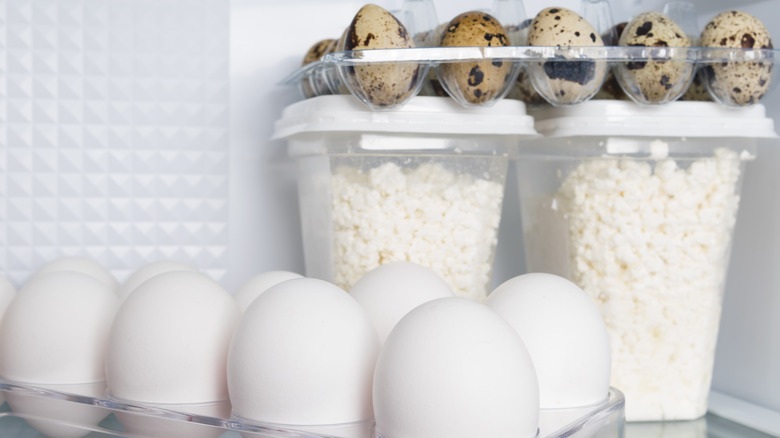If You Eat Expired Cottage Cheese, This Is What Happens
It's easy to lose track of what's in your refrigerator, especially if it's full of restaurant leftovers and samples from your cheese-of-the-month club. Sometimes a late-night snack is in order, so you search in the back of your fridge to find that cottage cheese you bought a while ago. It's not until you've eaten several spoonfuls that you realize the cottage cheese is past its expiration date.
Don't panic, unless the cottage cheese looked and tasted more like a science experiment. Although eating some mold can be safe, the Mayo Clinic says that cottage cheese with mold on it could have pathogens such as listeria or E. coli that could give you diarrhea, fever, or muscle aches. If your expired cottage cheese smells and tastes ok, it's probably safe to eat.
Besides, your cottage cheese probably doesn't have an expiration date but rather a "best by" date. According to the Food and Drug Administration, these are dates that food manufacturers put on their foods so you know when the product is of its best quality (BTW, here's the difference between the use-by, sell-by, and best-by dates). In most cases, it's safe to eat these unopened foods after their "best by" dates. Here's how you can tell whether or not to toss that cottage cheese.
How to tell if your cottage cheese is bad
Cottage cheese might have a bit of water floating at the top as the cheese begins to age. This is simply the whey separating from the curds. You can stir this water back into the cottage cheese curds and serve as usual. If it's too watery or slimy, then it's probably gone bad. Beware if the cottage cheese has some gray spots in it. That could be a sign of mold. Check the lid of the container for any gray or green spots.
Overall, your cottage cheese should have a smooth, creamy texture with its small curds. It shouldn't be grainy if it's been sitting in your refrigerator. However, if you've frozen your cottage cheese, it will appear to be a bit grainy. Although the U.S. Department of Agriculture says cottage cheese doesn't freeze well, you can still use it for casseroles such as lasagna.
Fresh cottage cheese is good for you and normally has a tangy smell. Cottage cheese is past its prime if it smells like yeast or if the smell is off-putting. Cottage cheese shouldn't taste sour, so if tasting it makes you wince, toss it. Above all, don't use cottage cheese that's been sitting out at room temperature for two hours. The USDA says bacteria thrive in temperatures above 40 degrees Fahrenheit and below 140 degrees Fahrenheit.
How to store cottage cheese
The "best by" date on cottage cheese assumes you haven't opened the container. Daisy Brand says you can still consume its cottage cheese after its "best by" date on the package as long as it hasn't been opened. Even if the "best by" date isn't for another month, the USDA says an opened container of cottage cheese will still retain its quality for a week in the refrigerator.
You can maximize the life of your cottage cheese if you store it in the back of your refrigerator so it doesn't encounter fluctuations in temperature from opening and closing your refrigerator door. Once you've removed the foil seal on your container of cottage cheese, you can keep it airtight by sealing off the container with cling wrap before replacing the lid.
(Read about the food storage mistakes that are twice as dangerous in the summer.)
If you choose to freeze it, be sure to place the container in a freezer-safe bag so it isn't exposed to air. It's also a good idea to write the current date somewhere on the container. However, Daisy Brand says the cottage cheese might not have the same flavor if it's been frozen.


